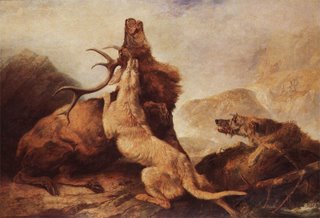Caledonians and the Deerhound 84AD

When the Romans Invaded almost 2 millenia ago, the island that was to eventually become Britian, little did they know that they would find to the north of this island, a people that would prove to be one of their most difficult and troublesome adversaries throughout the period of their great empire.
This land would be named Caledonia and populated by tribes of wild, earthy, ‘barbarians’, who looked physically different to the southerners and others tribes they had encountered. But interestingly, from descriptive texts kept by the Romans, we can build a picture of how they were, how they lived and of relevance here . . . the hounds they kept.
From the Geddes and Grosset ‘Ancient Scotland’ book comes the following detail . . .
”The Caledonians Reaction to Agricola’s invasion in 84 showed that they were capable of order and unity. They Lacked a coinage, They Lacked Bathhouses and they lacked imperial ambition. Their Technology was inferior to that of the Romans, although they had mastered Ironworking and some of them were accomplished workers in bronze. They decorated their bodies in a way that sugested a primitive wildness. They were skilled trackers, hunters and fishers, as well as pastoralists and farmers – country dwellers with no concept of town life or how to establish it. They kept animals – sheep, pigs, cows, dogs and horses and lived with them cheek by jowel. They made their own cloth and clothes. Their way of life was close to the soil but not bound to it – there was to much wild game to be caught for that to be necessary.“
We can surmise that the Caledonia who were also eventually reffered to as Pechti - a description (believed to be derogatory) relating to their country/rural ways - were tribes that existed largely through hunting. Although the landscape may have been quite different to that of today, with an abundance of birch, willow and rowan trees and rich with berry and bramble bushes, all ‘craw planted’ and mushrooms and fish filled streams a plenty, not forgetting the wild game, bears and wolves.
It is also said . . .
”The agricultural seasons determined and measured the pattern of their existence. Having come to a certain understanding of the universe, they lived their lives accordingly. They believed in the influences, baneful and benevolent, not only of a variety of gods or demigods, but also of local nature spirits. The reedy rippling tarn, the running river, especially at confluences, the silent wooded groves, certain mountains, fertile fields – all were sustained by tutelary spirits, whom it was well to respect and placate. Often the spirits were concieved in animal form (think Bran), and the present names of some streams and other features in Scotland still reflect this association.”
The people had a class of priest and/or magicians but they used neither reading nor writing. And this point is cruicial to the way tales of the Scottish past and tradditions are – Whatever they had of history, legend, lore and records was committed to memory and transferred verbally. In all these respects they were considered uncivilised, but in many respects this way has been maintained for 2000 years in the country of Scotland. This of course means that many in Scotland have been passed tales throughout generations relating to aspects of their heritage, which include the large grey hunting hounds and the respect for, and place amongst the tribes / clans and families, but because much of the history is through vocal transfer, much of it is discredited or treated with scepticism. This was never more obvious than when we observe the feud brought about by James Macpherson's Tales of Ossian and his detractor Dr. Samuel Johnson.
Back to hard evidence, there are objects found that point to proof of high artistic skill amongst the Caledonians dating from the first century, which were found in the same areas that would eventually be home to the Pictish arts in Moray and Aberdeenshire. Arts as we know depicted the hunt using large hounds. The ancestors of we deerhounds.
To find out more about the Caledonians simply click the link or here for a very good Scotland history website.
Labels: Roman Empire and Deerhounds


0 Comments:
Post a Comment
<< Home